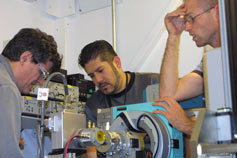
Handy Links
SLAC News Center
SLAC Today
- Subscribe
- Archives: Feb 2006-May 20, 2011
- Archives: May 23, 2011 and later
- Submit Feedback or Story Ideas
- About SLAC Today
SLAC News
Lab News
- Interactions
- Lightsources.org
- ILC NewsLine
- Int'l Science Grid This Week
- Fermilab Today
- Berkeley Lab News
- @brookhaven TODAY
- DOE Pulse
- CERN Courier
- DESY inForm
- US / LHC
SLAC Links
- Emergency
- Safety
- Policy Repository
- Site Entry Form

- Site Maps
- M & O Review
- Computing Status & Calendar
- SLAC Colloquium
- SLACspeak
- SLACspace
- SLAC Logo
- Café Menu
- Flea Market
- Web E-mail
- Marguerite Shuttle
- Discount Commuter Passes
-
Award Reporting Form
- SPIRES
- SciDoc
- Activity Groups
- Library
Stanford
Around the Bay
A Tale of Two Light Sources
 With the construction of the Linac Coherent Light Source (LCLS) moving ahead, SLAC is well on its way to having two x-ray light sources. SPEAR3, the synchrotron accelerator storage ring at SSRL, produces x-rays used by more than 2000 users and scientists a year. The LCLS will likewise produce powerful x-rays for a variety of research applications, but these two light sources will operate in fundamentally different
yet complementary ways.
With the construction of the Linac Coherent Light Source (LCLS) moving ahead, SLAC is well on its way to having two x-ray light sources. SPEAR3, the synchrotron accelerator storage ring at SSRL, produces x-rays used by more than 2000 users and scientists a year. The LCLS will likewise produce powerful x-rays for a variety of research applications, but these two light sources will operate in fundamentally different
yet complementary ways.
Several key distinctions will make the LCLS a very different machine from SPEAR3. Unlike SPEAR3, the LCLS will produce a coherent beam of x-ray laser light. Coherent x-rays are easier to focus to an extremely tiny spot size, making the LCLS a much more powerful microscope, and giving it the ability to make three-dimensional holographic images of sample molecules. The LCLS will also have the advantage of producing extraordinarily short pulses of x-rays—on the order of 100 femtoseconds, equivalent to the time light takes to travel the width of a human hair. Ultra-fast pulses will enable the LCLS to make stroboscopic images of ultra-fast phenomena, such as molecular vibration and chemical reactions as they happen. Each pulse will be billions of times brighter than those produced by SPEAR3—more x-rays per pulse mean more information can be obtained from a sample in a much shorter time.
By contrast, SPEAR3 may not produce the ultra-fast, ultra-bright x-ray pulses of the LCLS, but it will remain the workhorse of synchrotron science at SLAC for many years to come. Whereas the LCLS can only be tuned to produce x-rays in a very narrow energy range, SPEAR3 has the ability to produce a wide spectrum of x-rays useful for studying a variety of different materials. (Energy in this sense is the same thing as color in the visible spectrum—SPEAR3 can generate many "colors.") This flexibility, along with the availability of about two dozen experimental stations, makes SPEAR3 the tool of choice for the majority of users coming to SLAC to conduct research in fields including materials science, biochemistry and protein crystallography.
"The LCLS will serve an exciting scientific need, opening new frontiers in light source capabilities, but it will cater to a restricted set of users,” said SSRL Accelerator Systems Department head Bob Hettel. “While new capabilities on storage ring sources will also continue to develop, we'd lose our large user community without the established techniques available with SPEAR3."
—Brad Plummer, March 14, 2007
Above image: (From left) Vlad Vinetskiy, Renato Avilar, and Graeme Card working on SSRL's new protein crystallography station at Beamline 12. Protein crystallography is an important area of user research for which SPEAR3 is uniquely suited.